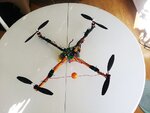jaosef
Newbie level 4
Hi, I've built a home made Arduino Quadcopter and made a video log of the build. The fligt time is about 30 minutes and the motor-to-motor size is about 152".

Enjoy!
https://www.youtube.com/watch?v=xUMeya-8dFQ

Enjoy!
https://www.youtube.com/watch?v=xUMeya-8dFQ